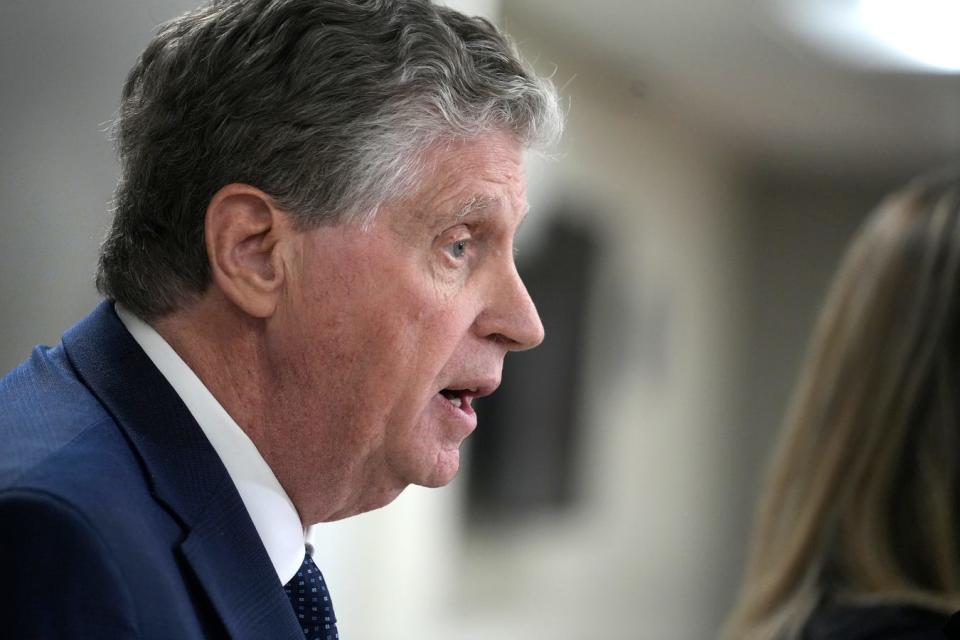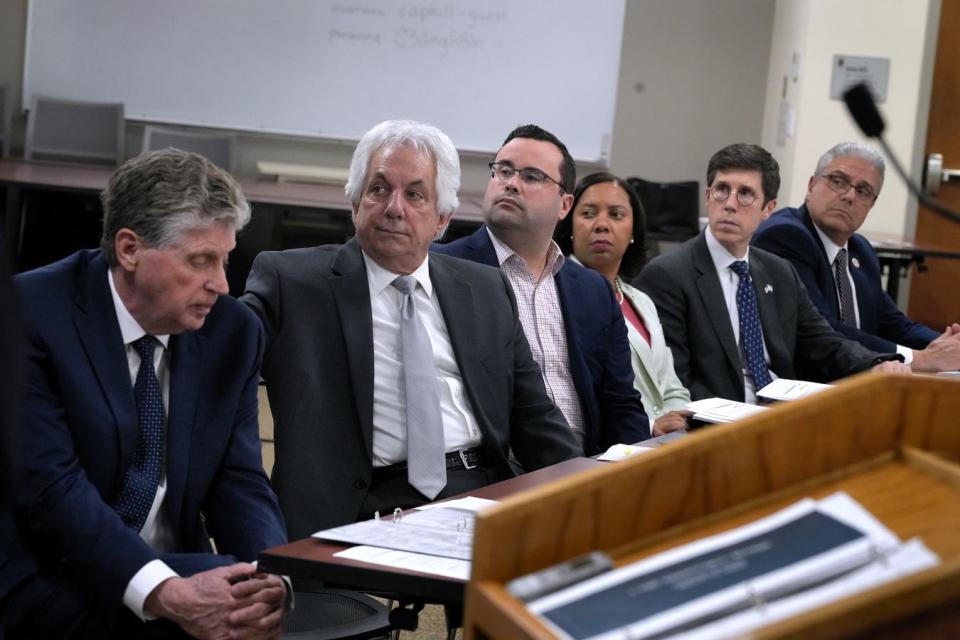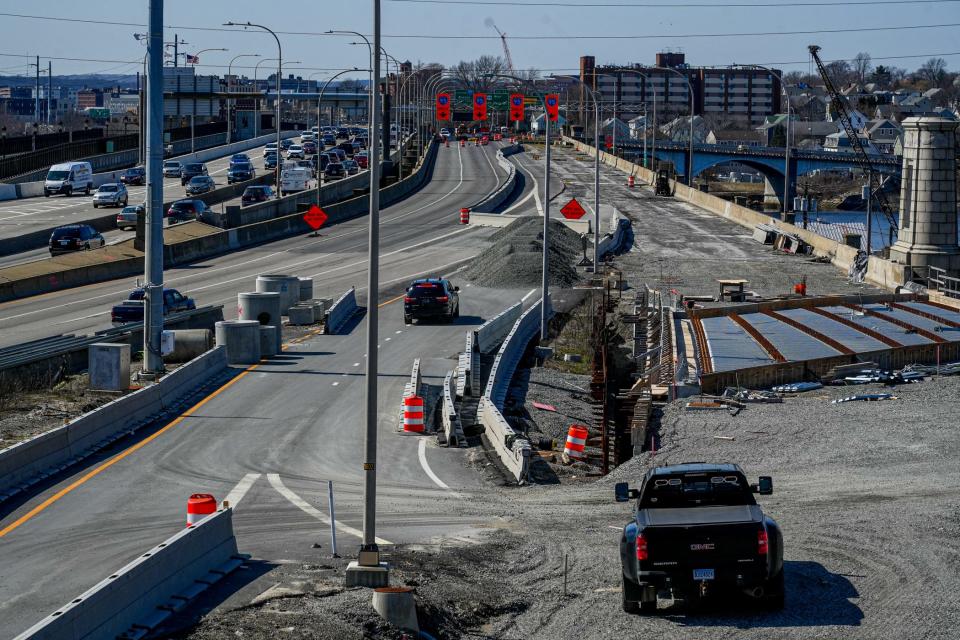Westbound Washington Bridge needs to be demolished. What it means for the state.
The westbound Washington Bridge will not be saved, Gov. Dan McKee announced Thursday after engineers recommended Rhode Island tear the structure down as soon as possible to begin a multi-year replacement project.
If demolition of the bridge begins by this summer, drivers can expect a new bridge to open by the end of 2026, an engineering firm hired by McKee to analyze the findings said. Building a new bridge is expected to cost up to $300 million.
The 1968 bridge was closed Dec. 11 to guard against collapse. Since then state bridge experts and engineering consultants have been analyzing the structure, which carried Interstate 195 West over the Seekonk River.
In-depth inspection and analysis identified “more problems” on top of those that triggered the bridge’s sudden closure in December and “structural deficiencies that cannot be viably repaired,” wrote Jeff Mehle, an engineer with McNary, Bergeron & Johannesen.
"I am deeply disturbed by the additional findings related to his project," McKee told reporters at an afternoon briefing. "This situation has been disruptive and challenging and it will contiue to be that way for a while, but we will do everything necessary to keep people safe."
Governor says Washington Bridge needs to be replaced
McKee hired McNary, Bergeron to "peer review" the work of a host of other engineering consultants examining the bridge, most of them working as subcontractors to the Barletta Heavy Division/Aetna Bridge construction consortium that was working on the span and found the critical structural damage.
All agreed that demolition and rebuild is the best option.
All of the upper portion of the bridge will need to come down and “part or all” of the piers and foundations in the river, the McNary, Bergeron report says.
It adds that at least two of a dozen tie-down rods on one of the piers failed and if all of them had broken part of the bridge would have fallen into the river.
“The decision to close the bridge was the right and responsible decision,” the report said.
'The day of accountability is coming'
The bridge was in poor condition when then-Gov. Gina Raimondo took office in 2015 on a platform of rebuilding the state’s bridges and hired Transportation Director Peter Alviti Jr. to lead the work.
Under Alviti, the DOT has twice embarked on multi-year repair projects of the Washington Bridge and has spent at least $53 million on them, most of which, if not all, will be wasted when the bridge comes down.
The state paid Cardi Corporation $18.3 million for a repair project that was abandoned before being finished in 2019.
After an aborted procurement and series of lawsuits, RIDOT hired Barletta/Aetna in 2021 to widen the bridge, add new ramps and make structural repairs. Through the end of last year Barletta had received $34.6 million out of what was supposed to be a $78 million contract.
Barletta is doing emergency work on the bridge now, including reworking the temporary traffic pattern on the shared eastbound span to add two new lanes and, ironically fixing the broken tie-down rods that will eventually be demolished. (Alviti said the bridge needs to be made stable to make demolition safer and easier.)
Another key player on the bridge is engineering firm AECOM, which worked for RIDOT designing the repair projects, modeling the traffic detours that went bad in 2018, writing the request for proposals for the latest work and performing a July inspection that gave the bridge a clean bill of health.
McKee described as good news the fact that the state will be able to repurpose "half" of the $78 million that was going to go to Barletta.
In his briefing with reporters, McKee hinted at legal action to recoup money from anyone who may have done something wrong while working on the bridge, but declined to name any targets.
Any legal action would only come after the results of a separate "forensic audit" of the bridge are released, which is expected in a couple of weeks.

"We will hold anyone responsible all responsible parties fully accountable," McKee said. "Today we are announcing that we will be replacing the bridge, but also accountability and the day of reckoning for those who are responsible for the position that we're in and the position that the people of the state of Rhode Island are in. That day is coming and it's coming very soon."
What about Alviti?
That reckoning appears not to extend, at least not yet, to Alviti, who signed off on two now worthless repair projects on a bridge that turns out to have been a lemon.
McKee said he had confidence in RIDOT leadership, although it was not the most ringing endorsement.
"I have confidence in DOT and the management team there and the director to start and complete this project," he said. "And then on the last point, again, I'm going to restate that that is a work in progress in terms of the accountability piece and we will keep you posted as we get that information."
He went on.
"I'm not happy about the fact of where we are right now. I don't know if you got that impression. I usually don't raise my voice, but I am not happy where we are right now. When I just told you that half of a $78 million project is, as it was just termed, going into the river... the good news there is that we've saved 40 million to actually get into the next step."

How will the bridge cost be split?
McKee said the expected split between federal and state government is 80%-20%, with the federal government paying the majority.
Assuming a $300 million total price tag, that means the federal government would pay $240 million and the state would need to pay $60 million.
House Speaker K. Joseph Shekarchi Thursday said he is "extremely concerned" about the price tag for the bridge replacement.
The cost of every project "since I've been speaker has always come in above estimate... The Tidewater stadium: above estimate, The health lab: above estimate. The state police barracks: above estimate."
On top of all that, Shekarchi said the state is going to need to get its applications for federal matching dollars in "as fast as possible to get it under consideration by Washington right now," before the November elections bring potential changes in the White House and the U.S. Senate.
Who will pay for it and how?
The "sources of funding are being developed," Alviti said.
They could include:
Federal grants
Federal transportation formula funds
Borrowing against expected federal wards, known as grant anticipation or GARVEE bonds
Taking money from other projects in the DOT's 10-year construction plan
The remainder (50%) of the $78 million in funds for the repair of the bridge before it needed to be demolished
What is the timeline for construction?
Within two weeks, the state will hire an owners representative for the bridge replacement project.
By July, Alviti said he expects to have chosen a company to design and build the new bridge. When that company is chosen, there will be a new update on the expected cost as well as the expected timeline for a new bridge to open.
Did the state consider hiring Barletta to build the new bridge under an emergency contract, potentially saving the months of time it will take to do a formal, conventional bidding process?
"We're going to go up for competitive bid because that's what we believe will get the best pricing and we'll also get the best quality of the individuals to do that work from demolition to replacing the bridge," McKee said.
Demolition is expected to be completed by March 2025.
The new bridge could open to traffic as early as February 2026 or, if things take longer, no later than September, 2026, McNary, Bergeron estimates.
"By the time the demolition is complete, it should be a seamless transition," Alviti said.
End of uncertainty a relief for Providence, East Providence mayors
Providence Mayor Brett Smiley and East Providence Mayor Robert DaSilva said now that there is a plan, for the bridge to be replaced, it helps them move forward.

"The biggest concern I've been hearing is the unknown," DaSilva said. "Now it looks like we have a plan, we know it's going to be replaced."
Smiley echoed DaSilva's comments and said more permanent signage for detours to the Henderson Bridge will start going up to help direct traffic.
The bridge replacement will take 18-24 months, need to be demolished in phases
Engineers said during the press conference that the demolition of the bridge will have to happen in a specific sequence, as the demolition will be a type of dismantling of the bridge, partly because of how it was built.
The demolition and construction is expected to take at least 18 months to two years.
While the bridge is being torn down, the state would then hire a firm to both design and build the new bridge and to start buying the materials required.
Alviti said the companies bidding to design and build a new bridge may want to keep the piers holding it up, or they may not want to reuse them and build new piers.
Condition of the bridge was worse than thought
The bridge carrying Interstate 195 West over the Seekonk River has been closed since December, when engineers working on a repair project noticed structural damage that showed it was at risk of collapse.
Since then a team of bridge experts – some working for the current contractor and others directly for McKee -- has studied what to do with the bridge.
The report from McNary, Bergeron confirms what other engineering consultants examining the bridge have concluded, that demolition and rebuild is the best option.
It adds that at least two of a dozen tie-down rods on one of the piers failed and if all of them had broken the bridge would have fallen into the river.
“The decision to close the bridge was the right and responsible decision,” the report said.
McKee said the superstructure and all or part of the substructure of the bridge must be replaced, according to the reports, as it was not just the tie down rods that were failing.
This article originally appeared on The Providence Journal: RI gives update on Washington Bridge demolition, timeline and replacement

